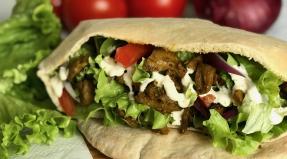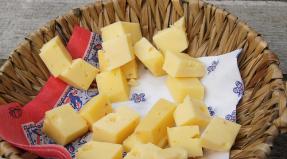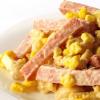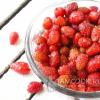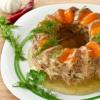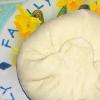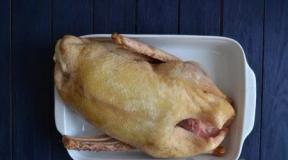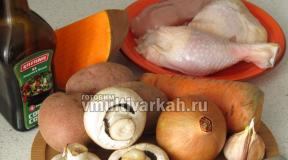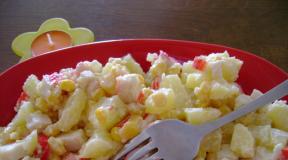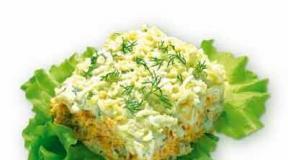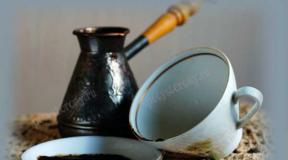How long to cook pasta. How to cook pasta in a pot so it doesn't stick together
What could be easier than boiling pasta in a saucepan? But very often, a catch lies in wait for hostesses: pasta (horns, shells) stick to each other, forming a lump of sticky mass. To prevent this from happening, you need to know a couple of secrets that will always allow you to serve delicious pasta which hold their shape perfectly and do not stick together. I share the knowledge that my grandmother passed on to me. Take note of my step-by-step recipe with photos taken for illustration.
So we need:
- pasta (horns) - 150 grams;
- water - 300 milliliters;
- salt (sea or ordinary) - 1 teaspoon;
- butter - 15 grams.
How to cook pasta in a pot
Before cooking, you need to choose pasta for cooking. It can be any kind pasta, such as: horns, stars, wheels, shells and so on. Today I cooked horns, which my family loves very much.
Pour 300 milliliters of water into the pan and send to the fire. Turn on the fire at maximum power so that the water boils in a matter of minutes. After all, we often cook pasta when we need to quickly cook something and there is no time to mess around in the kitchen for a long time.
After boiling, add a spoonful of salt. I use sea salt, which is also a source of iodine, which is very necessary for our body. This point is very important, because salt interacts with boiling water, so add salt only to boiled water.
IN salt water add horns or other pasta. Stir with a spoon and wait over high heat until the water boils again.
After that, reduce the fire to a minimum. Mix the horns well so that the starch that will stand out is evenly distributed in the water and the pasta does not stick together. Boil the pasta in the pan for about five minutes.

Then, turn off the heat and leave, under a closed lid, for another couple of minutes. Opening the lid, you can see that the pasta has swollen and increased in volume. It usually looks like this:

It remains just to throw the horns into a colander so that all the liquid is glassed. Rinse under cold running water to remove starch that can stick to pasta. The time for washing the pasta should not be long so that they do not cool down too much. After all, serving cold pasta to the table is not best idea. Therefore, you need to rinse for a couple of seconds, this is quite enough.

Return the pasta to the pan, drained of liquid, adding a pat of butter. Stir the horns until butter will not dissolve, but they will become oily and appetizing. You can replace the butter with vegetable oil, based on your personal taste preferences.

The whole process proper cooking pasta takes no more than ten minutes, which is very convenient.

You can serve horns, stars, wheels, shells and other pasta with meat, cheese, ketchup, sausages and so on.

Knowing how to cook pasta, they will always turn out very tender and tasty. Bon appetit and let pasta always turn out perfectly!
Boiled pasta - familiar and traditional side dish which is easy and quick to prepare. Knowing a few simple rules, even a novice hostess, a child and a husband, who is waiting for the return of his wife and newborn from the hospital, can cook the right pasta that does not stick together.
To make the pasta tasty, elastic and beautiful, you need to cook them in a large volume of water, which requires a rather large saucepan. The formula for calculating products is simple - 100:1000:10. It is the ratio of weight, volume and mass. That is, for every 100 grams of dry pasta, you need to take a liter of water, salt, of course, everything is added to taste, 10 grams is not an axiom.

The best pasta is made from durum wheat, so they keep their shape well and you need to make some effort to ready-made pasta stuck together. It is necessary to take into account the fact that pasta perfectly absorbs the taste of the water in which it is boiled, so it makes sense to use bottled or filtered water for cooking.

The cooking process begins from the moment the pasta is laid (remember - we don’t break long ones, spaghetti or noodles are placed vertically in pots and gradually go under water) only in boiling water. Pasta is boiled in boiling water, so if you turn down the heat, then just a little.

The cooking time of pasta depends on its shape, size and the dish being prepared. Usually the packaging indicates the approximate time, often two options, until fully prepared And al dente(on the tooth). Pasta cooked al dente, as a rule, is then supplemented with sauces, from where the pasta "gets" the necessary moisture.

You can check the readiness of pasta by tasting it, or, if it is long views pastas that are not very convenient to get out of boiling water by pressing on the pasta. If the pasta is easy to separate, then they are ready, if some effort is applied, you need to cook for another one or two minutes.

After cooking, the pasta should be thrown into a colander, rinsed only if the finished pasta was intended for salad. After draining the water, return the pasta to the pan and add oil - , or , to taste. Shake the pot well, after closing the lid tightly. Ideal serving of pasta - immediately after cooking, if this does not work out, after 8-10 minutes, shake the pasta pan again to avoid sticking.

Properly cooked pasta will never harm your figure, of course, if they are not eaten in kilograms.
Macaroni is an internationally recognized side dish. Italians are the originators of pasta. The composition of this product is very simple: water and flour. Therefore, there is no particular use in this side dish, except for the moment when they are really high quality and made from durum varieties wheat, which have in their composition fiber, which helps to cleanse the body. Pasta is a simple dish and everyone can cook them. However, not everyone knows how much to cook pasta so that they do not stick together and turn into porridge. Experienced housewives have in their arsenal many secrets of high-quality cooking of this product.
What varieties to choose
 Due to the popularity of this side dish, store shelves are filled with various types of pasta, they can be divided into weighted and packaged. Also, products are divided into different types according to their shape: spaghetti, spirals, horns, shells, stars, and so on. Of the variety of forms, the choice should be made only from personal preferences, who likes what. In addition, now you can find pasta from various kinds flour: buckwheat, rice and so on.
Due to the popularity of this side dish, store shelves are filled with various types of pasta, they can be divided into weighted and packaged. Also, products are divided into different types according to their shape: spaghetti, spirals, horns, shells, stars, and so on. Of the variety of forms, the choice should be made only from personal preferences, who likes what. In addition, now you can find pasta from various kinds flour: buckwheat, rice and so on.
Classic pasta is made only from wheat flour hard varieties, they should be chosen from a variety of offers. Such products are easy to weld, and they do not stick together, unlike cheaper counterparts. When choosing a product, you need to pay attention to the packaging if it has a group A or top grades, then this is exactly the pasta that is worth buying.
There are group B products made from soft varieties. This is a budget version of the product, they are inexpensive, but their quality is not the best. Cooking such pasta so that they do not stick together is extremely difficult.
The best are considered italian pasta, but the price of the product is also quite high. However, once you taste the real Italian pasta, taste never forget and compare them with budget option pasta is not possible.
cooking secrets
 Cooking pasta in a saucepan seems like a piece of cake, but it's only at first glance. It is worth overdoing or not guessing with the amount of water, and instead of a side dish you get porridge from dough and a boiled sticky lump. Therefore, in the preparation of pasta, it is worth adhering to certain rules.
Cooking pasta in a saucepan seems like a piece of cake, but it's only at first glance. It is worth overdoing or not guessing with the amount of water, and instead of a side dish you get porridge from dough and a boiled sticky lump. Therefore, in the preparation of pasta, it is worth adhering to certain rules.
Advice! To prevent the pasta from sticking together, you need to pour a large spoonful of vegetable oil into the water and actively mix the contents of the pan.
in a saucepan
 Cooking a side dish in a saucepan is the most common way. You need to choose a sufficiently voluminous pan, and pour water into it, the amount of liquid should be large. Half a standard pack of pasta needs about three liters of water. Boil water and salt.
Cooking a side dish in a saucepan is the most common way. You need to choose a sufficiently voluminous pan, and pour water into it, the amount of liquid should be large. Half a standard pack of pasta needs about three liters of water. Boil water and salt.
Place pasta only in boiling water, and mix quickly so that they do not have time to stick together and stick to the pan. If they are not mixed immediately, then no matter how many minutes to cook the pasta, they will still be lumpy. If you need to cook spaghetti, then there is no need to break them in order to immerse them entirely in water, just put them on and wait until the lower part becomes soft. They will gradually sink into the water themselves, it is important not to forget to stir.
Cook the side dish with the lid open and over low heat. Cooking time is 5-10 minutes depending on the size and thickness of the product. After the garnish is cooked, it must be thrown into a colander and, if necessary, rinsed with water. It should be noted that washing cold water not worth it, it is better to rinse with hot if necessary.
Cooking with kitchen appliances
 For a long time, various kitchen appliances such as slow cooker, steamer and microwave. You can also cook pasta in them.
For a long time, various kitchen appliances such as slow cooker, steamer and microwave. You can also cook pasta in them.
- In the microwave, the product will cook in 10 minutes at full power. The ratio of salted water and pasta should be 2 to 1, the water should hide them completely.
- In the "Steam cooking" mode, pasta will be cooked in a slow cooker in 12 minutes. It is important to pour right amount water, it should hide the garnish by two centimeters. In addition, you need to add salt and butter.
- Pasta in a double boiler is considered the most useful. You need to cook from 15 minutes. Then also put in a colander and drain the excess liquid.
Particularly sophisticated chefs manage to cook a side dish even in an electric kettle. Despite the fact that it resembles fiction, everything is quite real. It is necessary to boil water in the kettle, add pasta and for 7 minutes press the kettle button with a short interval of half a minute, then drain the water and take out the finished side dish.
When observing the cooking time, it is important to pay attention to the readiness of the product. Sometimes the specified time may not be enough. You can check the readiness by tasting the dish. By the way, in Italy, slightly undercooked pasta is considered an indicator of good taste.
Surely every housewife knows how to cook pasta. But few of the culinary experts think that this simplest process has its own secrets. To make pasta always tasty and not stick together, you should use some tricks.
How to cook pasta properly?
The main question in the process of preparing the most popular side dish: how much to cook pasta? Exact time depends on which cooking method is chosen, as well as on the variety and quality of the product. It is important to choose the right utensils for cooking pasta.
in a saucepan



Most often, pasta is cooked in a saucepan. It is best to use a container with a thick bottom for this process. First, the pan is filled with filtered water. Ideal Proportions: liter of water per 100 g of product. If there is not enough liquid in the container, the dish will turn out to be too sticky. Usually, for a family of three, 300 g of pasta and 3 liters of clean water are taken.
The product is lowered into actively boiling water. Salt it first to taste. In this case, the heating of the plate should be maximum. Immediately after immersing the pasta in the liquid, the pan is tightly covered with a lid. After re-boiling the lid is removed and the fire is reduced.
Immediately after adding the pasta to the water, mix well to prevent sticking. Next, the side dish is cooked for 10-12 minutes.
In a slow cooker
Ingredients: 1 cup pasta, 380 ml filtered water, salt, seasonings to taste, a piece of butter.

- First of all, the prepared liquid is poured into the bowl of the "smart pot". Salt is immediately poured into the water, and selected seasonings are added.
- The "Paste" mode is set in the menu. After the signal that the liquid is boiling, pasta is laid out in it. Next, the dish is cooked for 8 minutes. If in the end it turns out to be not ready, you can extend the process for another same amount of time.
The resulting side dish is leaned back in a colander and flavored with butter.
in the microwave
Ingredients: 220 g pasta, 2 times more filtered water, 1 tbsp. a spoon refined oil, salt taste.



- To cook pasta in this way, you need to choose a deep dish suitable for the microwave oven.
- First, the container is sent to the device at maximum power for 12-15 minutes until the liquid boils.
- Boiling water can be salted, pour oil into it. Pasta is dipped into the mixture. The oil will keep them from sticking.
- The products are well mixed, and the container is returned to the oven for 20 minutes at medium power.
It remains to throw the pasta in a colander and you can take a sample.
In a double boiler
Ingredients: 350-370 g pasta, 1 tbsp. a spoonful of refined oil, salt, seasonings, water.

- First, water is poured into the steamer container intended for rice. There should be enough liquid so that its level is about 1.5 cm higher than the layer of pasta.
- Salt, seasonings and oil are immediately added to the water.
- Pasta is immersed in the liquid, after which the device closes and turns on.
The dish is prepared in 20-25 minutes. Rinse the pasta with warm water.
Al dente pasta - how long to cook?



Slightly undercooked al dente pasta is used for compound dishes. For example, when spaghetti ends up paired with sauces or separately cooked meats. If you add ready-made pasta to a boiling sauce, then in the end they will boil quickly. The al dente condition makes it ideal for preparing a compound pasta dish. An extra couple of minutes of languor will bring them to full readiness.
Selected pasta is immersed in actively boiling salted water. Next, you need to pinpoint 3-4 minutes. After that, the semi-finished product is left to stand in water for a couple of minutes, leans back in a colander and rinsed with water.
Secrets of cooking different types of pasta
The hardest part is figuring out how to cook pasta nests. This base allows you to delicious dish with vegetable and meat fillings.

The nests are carefully lowered into boiling water and boiled according to the principle regular pasta until ready. The main thing is not to stir them and carefully remove them from the pan with a slotted spoon. You can remove undercooked nests from the container, cover them with stuffing and send them to bake in the oven.



Spider web vermicelli is cooked very quickly and simply. If it becomes part of the soup, then you can add it to the pot with the first course 5 minutes before cooking. Separately, the product is boiled for the same amount of time in salt water with a small amount of vegetable oil.

To cook spaghetti deliciously, you can dip them both in boiling water and in milk. You need to check the readiness of the dish every 3 minutes. As soon as the product becomes soft, but elastic, you can remove the pan from the heat.



If large spirals or shells are chosen, then they will need to be cooked a little longer in time. Until fully cooked, such products need to be held in boiling water for 12-14 minutes.
Do I need to rinse pasta after cooking, and with what water?
Experienced chefs from Italy consider the habit of Russian housewives to wash pasta with cold water a big mistake. In the process, the product cools down and loses its taste, and, in addition, the starch necessary for the excellent absorption of sauces is washed off.

It is up to each housewife to decide whether it is worth rinsing cooked pasta. Be sure to rinse the product with water if the pasta is intended for making salad.

But even these precautions are not enough. To definitely protect the dish from sticking, you just need to add to the water during cooking vegetable oil. Enough 1-2 teaspoons.
My first attempt at cooking pasta ended in failure. I put a big pack of pasta in cold water, put the pan on the fire and waited ... As a result, I got a viscous pasta mass stuck together in one lump, besides, this mass burned tightly to the bottom of the pan. I had to throw everything away.
Now I know how to boil and how to make them not stick together. Pasta is poured only into boiling salted water, and there should be a lot of water. Even if you decide to boil only 100 grams of pasta, take at least a liter of water.
Italians, experts in cooking pasta, advise adding a little to boiling water before throwing pasta olive oil. Oil is added to prevent noodles, spaghetti and other pasta from sticking together.
At the end of cooking, the contents of the pan are filtered through a colander, oil, sauce, etc. are added to the boiled pasta.
Cooking steps:





Ingredients:
Water 3 l, pasta 400 g, butter 30 g, salt 1/2 tbsp. spoons.
